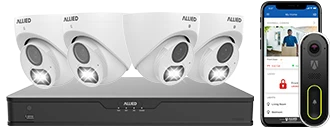Introduction to Alarm Systems
Alarm systems are essential tools designed to detect unauthorized entry, criminal activity, or other unwanted occurrences in residential, commercial, and industrial spaces. The primary function of these systems is to enhance security and ensure the safety of individuals and property by alerting occupants and, in many instances, local authorities.
Alarm systems have evolved significantly over the years. Early models were rudimentary and primarily involved simple mechanisms to alert occupants of intruders. However, advances in technology have led to the development of more sophisticated systems, which incorporate a variety of sensors, communication methods, and integration capabilities.
Modern alarm systems can be broadly categorized into four main types: wired, wireless, smart, and hybrid. Each type offers distinct advantages and applications depending on the specific needs and conditions of the environment they are protecting.
Types of Alarm Systems
- Wired Alarm Systems: These systems rely on physical wiring to connect sensors and control panels. They are known for their reliability and have been extensively used in both residential and commercial properties.
- Wireless Alarm Systems: Unlike wired systems, wireless alarms use radio frequency signals to communicate between sensors and control units. They offer flexibility in installation and are less invasive.
- Smart Alarm Systems: These systems leverage internet connectivity to integrate with home automation technologies. They can be controlled remotely using smartphones or other smart devices.
- Hybrid Alarm Systems: Combining the best of both wired and wireless technologies, hybrid systems provide a balance of reliability and flexibility.
The choice of alarm system depends on various factors, including the location, specific security needs, budget, and the desired level of technology integration. Understanding these different types of alarm systems is crucial for making an informed decision about which solution best fits your security requirements.
Wired Alarm Systems: Technology and Applications
Wired alarm systems have been a cornerstone of security technology for decades. These systems are known for their reliability and longevity due to the physical connections between components. Unlike wireless systems, which rely on radio frequencies, wired alarm systems use cables to connect sensors, detectors, and control panels. This direct connection often results in fewer false alarms and more stable communication.
One of the primary advantages of wired alarm systems is their robustness. Because they are hardwired into a building’s electrical system, they are less susceptible to interference from other electronic devices. This stability makes wired systems particularly suitable for large facilities such as commercial buildings, industrial sites, and multi-story residences.
Further, wired alarm systems generally require less frequent maintenance compared to their wireless counterparts. Since there are no batteries to replace, the upkeep involves regular inspections to ensure the integrity of the connections and functionality of the system components. This can be particularly advantageous in environments where constant system reliability is critical.
However, installation of wired alarm systems can be labor-intensive and expensive. The process often involves drilling into walls, running cables through ceilings, and other structural modifications. This makes wired systems less feasible for older buildings or structures where extensive rewiring can be disruptive and costly.
In terms of technology, wired alarm systems often incorporate a variety of sensors and detectors:
- Door and Window Sensors: These sensors typically use magnetic contacts and are installed on doors and windows to detect unauthorized openings.
- Motion Detectors: Utilizing infrared or ultrasonic technology, these detectors sense movement within a designated area, triggering an alarm if unexpected motion is detected.
- Glass Break Detectors: Equipped with microphones, these sensors are designed to pick up the specific frequency of breaking glass, providing additional security for windows and glass-fronted areas.
- Smoke and Heat Detectors: Often integrated into wired systems for comprehensive safety, these detectors alert occupants in the event of fire hazards.
Wired alarm systems are typically control
led via a central control panel, which is used to arm and disarm the system, monitor the status of various sensors, and provide alerts in case of a security breach. Modern control panels may also offer digital displays, keypad controls, and connectivity to remote monitoring services.
In conclusion, while wired alarm systems may involve a higher initial investment and more complex installation, their reliability and minimal maintenance requirements make them a valuable choice for many types of applications, especially where system stability and integrity are paramount.
Wireless Alarm Systems: Advancements and Trends
Wireless alarm systems have significantly evolved over the years, driven by advancements in technology and a growing demand for flexible security solutions. As opposed to wired systems, wireless alarm systems utilize radio frequency (RF) signals to communicate between various sensors and the central control panel. This not only reduces the need for extensive wiring but also simplifies installation and enhances scalability.
Advancements in Wireless Alarm Systems
The development of wireless technology has introduced several key advancements in alarm systems:
- Enhanced Communication Protocols: Modern wireless alarm systems leverage advanced communication protocols such as Zigbee, Z-Wave, and Wi-Fi. These protocols offer secure, reliable, and efficient data transmission between devices, ensuring prompt alert notifications.
- Battery Life Improvements: Advances in battery technology have significantly extended the operating life of wireless alarm components. Many sensors and devices now feature batteries that can last several years, reducing maintenance frequency.
- Mobile Accessibility: Integration with mobile apps allows users to monitor and control their alarm systems remotely. This provides real-time alerts and the ability to arm or disarm the system from a smartphone or other mobile device.
Trends in Wireless Alarm Systems
The market for wireless alarm systems continues to grow, driven by several emerging trends:
- DIY Installations: The ease of installation associated with wireless systems has led to a rise in do-it-yourself (DIY) security solutions. Consumers can purchase, install, and set up their alarm systems without professional assistance, making home security more accessible.
- Integration with Smart Home Devices: Wireless alarm systems are increasingly compatible with smart home ecosystems, allowing them to integrate with devices such as smart locks, lights, and cameras. This creates a unified security and automation solution that enhances overall convenience and control.
- Adoption of AI and Machine Learning: Some advanced wireless alarm systems incorporate artificial intelligence (AI) and machine learning algorithms to reduce false alarms and improve detection accuracy. These systems can learn the habits and routines of household occupants, distinguishing between normal activity and potential security threats.
Wireless alarm systems represent a significant step forward in home and business security, providing flexibility, ease of use, and integration capabilities that cater to modern security needs. As technology continues to advance, it is likely that wireless alarm systems will become even more sophisticated, offering enhanced protection and convenience for users.
Smart Alarm Systems: Integration with Smart Homes
Smart alarm systems have revolutionized the way home security integrates with modern living. These systems leverage advanced technology to offer a seamless experience, connecting various security components through the Internet of Things (IoT) to provide enhanced protection and convenience.
Integration with Smart Home Devices
One of the key features of smart alarm systems is their ability to integrate with other smart home devices. This connectivity allows users to control multiple aspects of their home security and automation through a central interface, such as a smartphone app or a voice assistant. Popular devices that can be integrated include:
- Smart locks: Allow users to lock and unlock doors remotely, providing access control and monitoring capabilities.
- Smart cameras: Offer real-time video monitoring and recording, with some models featuring facial recognition and motion detection.
- Smart lights: Can be programmed to turn on or off in response to alarms or based on user-defined schedules, enhancing both security and energy efficiency.
- Smart thermostats: Regulate home temperature and can be integrated to help detect fires or other emergencies.
Remote Monitoring and Control
Smart alarm systems provide remote monitoring capabilities, allowing users to check the status of their security system and receive alerts no matter where they are. This is made possible through smartphone applications that offer features such as:
- Real-time notifications: Users receive alerts for detected intrusions, smoke, carbon monoxide, and other hazards.
- System arming and disarming: Allows users to control the alarm system remotely, providing flexibility and peace of mind.
- Activity logs: Users can review historical data and events, helping to identify patterns or anomalies.
Artificial Intelligence and Machine Learning
Many smart alarm systems incorporate artificial intelligence (AI) and machine learning algorithms to enhance their effectiveness. These technologies enable the system to learn user behaviors and make intelligent decisions, such as differentiating between actual threats and false alarms. Key AI-based features include:
- Facial recognition: Identifies and verifies known individuals, reducing the likelihood of false alarms.
- Advanced motion detection: Distinguishes between humans, pets, and other moving objects to minimize unnecessary alerts.
- Predictive analytics: Analyzes patterns and trends to anticipate potential security breaches and recommend preventive actions.
Integration with Emergency Services
In the event of an emergency, smart alarm systems can be configured to automatically alert local authorities and emergency services. This feature ensures a rapid response, which can be crucial in situations such as break-ins or fires. Many systems offer:
- Automated emergency calling: Immediate notification to police, fire departments, or medical services.
- Two-way communication: Allows users to speak directly with emergency responders through integrated systems.
Customization and Scalability
Smart alarm systems are highly customizable, allowing users to tailor the system to their specific security needs. They are also scalable, making it possible to add additional devices and features over time. Customization options include:
- Sensor selection: Choose from a variety of sensors, such as door/window sensors, glass break detectors, and environmental sensors.
- Notification preferences: Customize how and when to receive alerts, including through emails, text messages, or app notifications.
- Integration options: Expand the system by adding new smart home devices as technology advances and needs change.
In summary, smart alarm systems offer a comprehensive, connected, and intelligent approach to home security. Their ability to integrate with other smart home devices, provide remote monitoring, leverage AI for enhanced detection, and offer customization makes them a compelling option for modern homeowners seeking robust protection and convenience.
Hybrid Alarm Systems: Combining Wired and Wireless Features
Hybrid alarm systems combine the advantages of both wired and wireless alarm systems, providing greater flexibility and reliability. These systems are designed to optimize the strengths of each type of technology while minimizing their respective weaknesses.
Advantages of Hybrid Alarm Systems
One of the main benefits of hybrid alarm systems is their enhanced reliability. By using a combination of wired and wireless components, these systems reduce the risk of a single point of failure, offering a more robust security solution.
Hybrid systems also offer increased flexibility in installation. Existing infrastructure can be utilized by integrating wired elements with new wireless components, making them suitable for both new construction and retrofit applications. This flexibility allows for easier expansion and customization compared to solely wired or wireless systems.
Installation and Configuration
Installation of hybrid alarm systems can be more complex due to the integration of both wired and wireless elements. Professional installation is often recommended to ensure proper configuration and optimal performance. Installers must assess the site to determine the best combination of wired and wireless components based on the building’s layout and the user’s specific security needs.
Once installed, these systems can typically be managed through a central control panel, which may also feature remote access capabilities. Users can monitor and control their system via smartphones or other devices, providing convenience and peace of mind.
Components of Hybrid Alarm Systems
The components of a hybrid alarm system generally include:
- Control Panel: Acts as the central hub, integrating and managing both wired and wireless components.
- Sensors: A mix of wired and wireless sensors, including motion detectors, door/window contacts, and glass break sensors.
- Siren/Alarm: Can be wired or wireless, depending on the setup, and used to alert occupants and deter intruders.
- Communication Modules: These modules ensure communication between the system and monitoring services, which might use landline, cellular, or internet connections.
Use Cases and Applications
Hybrid alarm systems are particularly beneficial in larger properties or facilities with complex layouts. These systems are often used in commercial establishments, industrial facilities, and larger residential properties where a single type of system might not provide adequate coverage.
Additionally, hybrid systems can be an excellent choice for properties undergoing gradual upgrades. Owners can start with a wired system and incrementally add wireless components as needed, ensuring an up-to-date security solution without the need for extensive rewiring.
Conclusion
Hybrid alarm systems offer a versatile and reliable security solution, combining the best features of wired and wireless technologies. Their flexibility makes them suitable for a wide range of applications, from residential to commercial settings. While more complex to install, their benefits in terms of reliability and customization make them an excellent choice for comprehensive security needs.
Choosing the Right Alarm System: Factors and Best Practices
When it comes to choosing the right alarm system, several key factors need to be taken into account to ensure that the system meets your specific needs and provides the desired level of security. Below are some critical factors and best practices to consider:
1. Type of Property:
The type of property you are securing plays a significant role in determining the appropriate alarm system. For example, residential properties may prioritize ease of use and integration with smart home systems, while commercial properties might require more robust, scalable systems with extensive monitoring capabilities.
2. Installation Costs:
Cost is an important factor. Wired systems often come with higher installation costs due to the need for professional installation and the complexity of wiring throughout the building. Wireless systems, on the other hand, tend to have lower installation costs but might incur higher ongoing maintenance or component replacement costs.
3. Ease of Maintenance:
Maintenance requirements vary significantly between alarm systems. Wired systems generally require less frequent maintenance once installed, as they are less susceptible to interference. Wireless systems, however, might need more regular maintenance checks for battery replacements and software updates.
4. Scalability:
If you anticipate needing to expand your alarm system in the future, scalability is a crucial factor. Wireless and hybrid systems generally offer more flexibility and easier scalability compared to fully wired systems.
5. Reliability:
Reliability is paramount in any alarm system. Wired systems are typically very reliable due to their direct connections, which are less prone to interference or signal loss. However, advancements in wireless technology have significantly improved the reliability of wireless systems, making them a competitive option.
6. Integration with Other Systems:
Modern alarm systems often integrate with other security and home automation systems. If you already have a smart home setup or plan to build one, a smart alarm system or a hybrid system with smart capabilities might be the best choice. Ensure the alarm system you choose is compatible with your existing smart devices.
7. Monitoring Services:
Decide whether you require professional monitoring services. Some alarm systems come with optional subscriptions for professional monitoring, which can provide an additional layer of security by ensuring that authorities are alerted in case of an emergency.
8. User-Friendliness:
The usability of the alarm system is another important factor. Systems that are overly complex can lead to user error, reducing overall effectiveness. Choose a system that matches your ability to operate it comfortably, including features like mobile app control, easy-to-read displays, and user-friendly interfaces.
9. Regulatory and Compliance Requirements:
Ensure that the alarm system complies with any relevant local, state, or country-specific regulations or standards. This is particularly important for commercial properties, which may be subject to stricter regulations.
By considering these factors and following best practices, you can make a well-informed decision about the alarm system that best suits your needs, ensuring that you achieve a balance between cost, reliability, and functionality.












